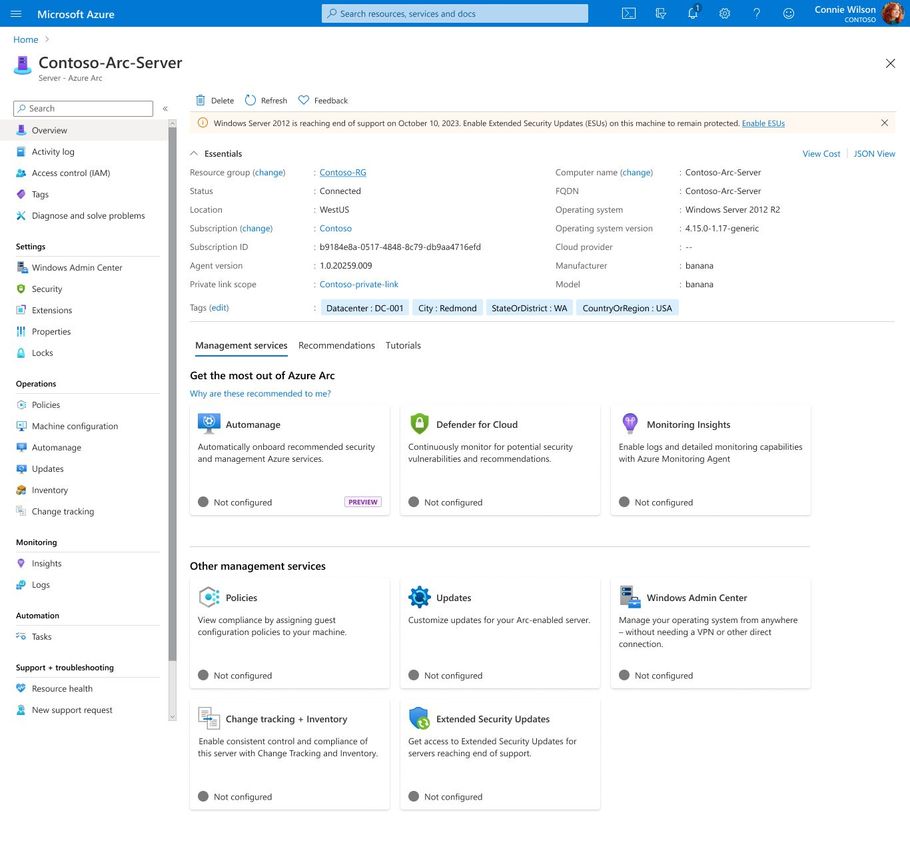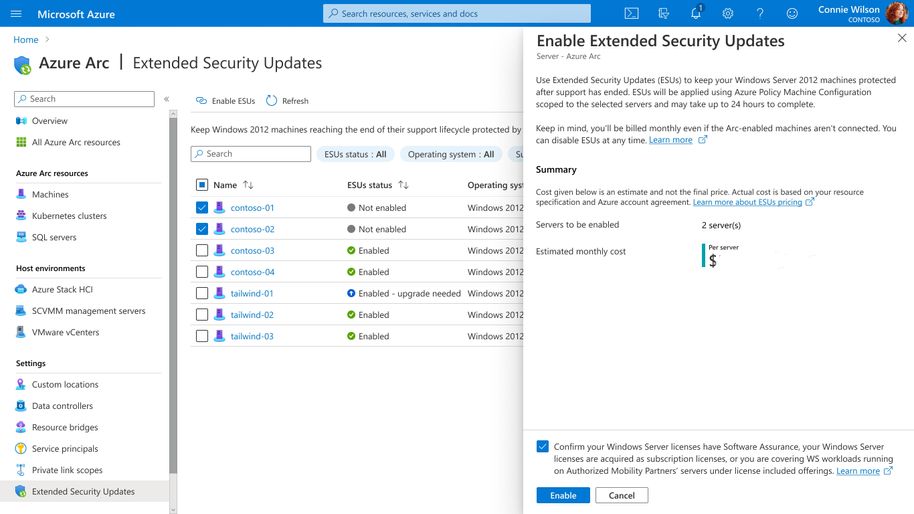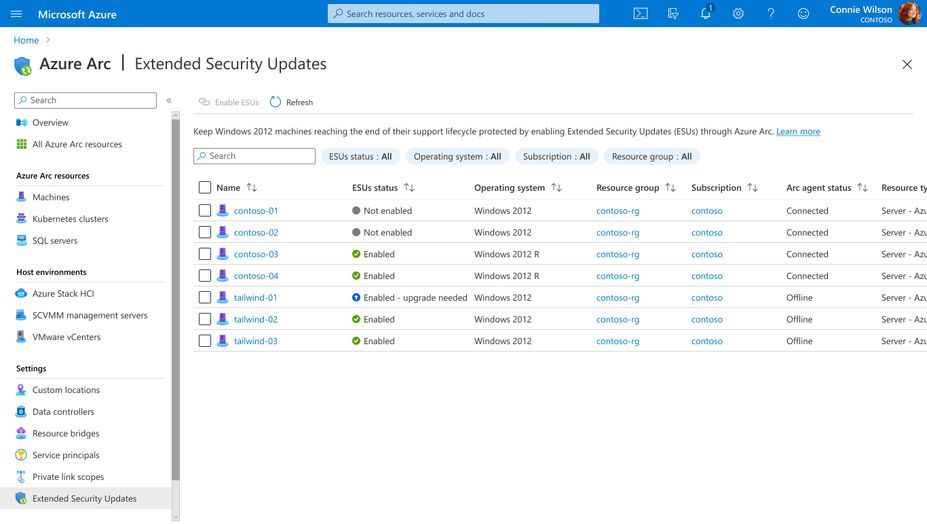New options for Extended Security Updates enabled by Azure Arc

With Azure Arc, we want to empower businesses to transcend cloud boundaries and innovate from the cloud to the edge. As part of our commitment to enable seamless management. security, and innovation across diverse environments, we want to share a new offering today to help secure your end-of-support OS starting with Windows Server 2012 and SQL Server 2012.
We’re approaching some critical end-of-support (EoS) milestones for Windows Server 2012/R2 (October 10, 2023) and SQL Server end-of-support (July 2012, 2023 – end of year 1 for ESUs). We recognize that in some instances, customers are unable to migrate their IT infrastructure to Azure by the deadlines and need their Windows Server 2012 or SQL Server 2012 resources to stay on-premises to support their business-critical applications. To secure their EoS resources in the cloud or on-premises, many customers enroll in Extended Security Updates to avoid data breaches, malware infections, and other security breaches, which could potentially result in significant financial loss, reputational damage, and legal ramifications.
Today, we’re announcing Extended Security Updates enabled by Azure Arc for Windows Server 2012/R2 and SQL Server 2012 (year 2 onwards), a new and enhanced cloud experience alternative to traditional Extended Security Updates (classic). With this new option, security updates will be natively available in the Azure Portal through Azure Arc for resources for up to 3 years.
Extended Security enabled by Azure Arc is the best way for customers to get trusted security updates and benefit from cloud capabilities including discovery, management, and patching, all in one offering. Here are some key benefits:
- Inventory and management: After deploying Azure Arc, customers can discover their Windows Server 2012 and SQL Server 2012 resources and manage the enrollment of Extended Security Updates in the Azure portal.
- Pay as you Go billing: Customers will be charged on a monthly basis to enable flexibility for managing their costs and timelines.
- Keyless delivery: Azure Arc-enabled machines do not require the acquisition or activation of keys for Extended Security Updates.
- Modernize: Add Azure services like Microsoft Defender, Microsoft Sentinel, SQL Managed Instance, Azure Monitor, and more in your preferred environment.
- Azure investments: Customers can leverage their Microsoft Azure Consumption Commitment (MACC) investments and manage their costs using Azure Cost Management.
How to deploy Extended Security Updates enabled by Azure Arc
Customers should start with enabling Azure Arc on their servers with their preferred option for deployment and networking.
- Establish Azure foundation. Create an Azure account, setting up billing alongside the subscriptions and resource groups to server as a landing zone for your Arc-enabled servers.
- Define networking approach. Select from public endpoint, proxy server, and private endpoint connectivity options to meet your organization’s networking requirements.
- Onboard to Azure Arc. Install the Azure Connected Machine agent to connect your servers to Azure with the flexibility of at-scale deployment options like Group Policy and Configuration Manager.
- Deploy Extended Security Updates: Once onboarded, the servers will be visible in the Azure portal with an option for activating Extended Security Updates for Windows Server 2012 Standard and R2 through the Azure portal or Azure Policy.
Get started today!
Extended Security Updates enabled by Azure Arc are available today for purchase for Windows 2012/2012 R2 and SQL Server 2012. To prepare for the deployment, customers should ensure that their Windows Server 2012, Windows Server 2012 R2, and SQL Server 2012 machines are onboarded to Azure Arc by September 2023.
Learn more:
- Extended Security Updates enabled by Azure Arc technical documentation: Extended Security Updates (ESUs) enabled by Azure Arc
- Windows Server 2012 End of support blog: https://aka.ms/ws2012eosInspireblog
- SQL Server 2012 End of support blog: https://aka.ms/SQL2014EoSArcESU
Published on:
Learn moreRelated posts
Fabric Mirroring for Azure Cosmos DB: Public Preview Refresh Now Live with New Features
We’re thrilled to announce the latest refresh of Fabric Mirroring for Azure Cosmos DB, now available with several powerful new features that e...
Power Platform – Use Azure Key Vault secrets with environment variables
We are announcing the ability to use Azure Key Vault secrets with environment variables in Power Platform. This feature will reach general ava...
Validating Azure Key Vault Access Securely in Fabric Notebooks
Working with sensitive data in Microsoft Fabric requires careful handling of secrets, especially when collaborating externally. In a recent cu...
Azure Developer CLI (azd) – May 2025
This post announces the May release of the Azure Developer CLI (`azd`). The post Azure Developer CLI (azd) – May 2025 appeared first on ...
Azure Cosmos DB with DiskANN Part 4: Stable Vector Search Recall with Streaming Data
Vector Search with Azure Cosmos DB In Part 1 and Part 2 of this series, we explored vector search with Azure Cosmos DB and best practices for...
General Availability for Data API in vCore-based Azure Cosmos DB for MongoDB
Title: General Availability for Data API in vCore-based Azure Cosmos DB for MongoDB We’re excited to announce the general availability of the ...
Efficiently and Elegantly Modeling Embeddings in Azure SQL and SQL Server
Storing and querying text embeddings in a database it might seem challenging, but with the right schema design, it’s not only possible, ...


